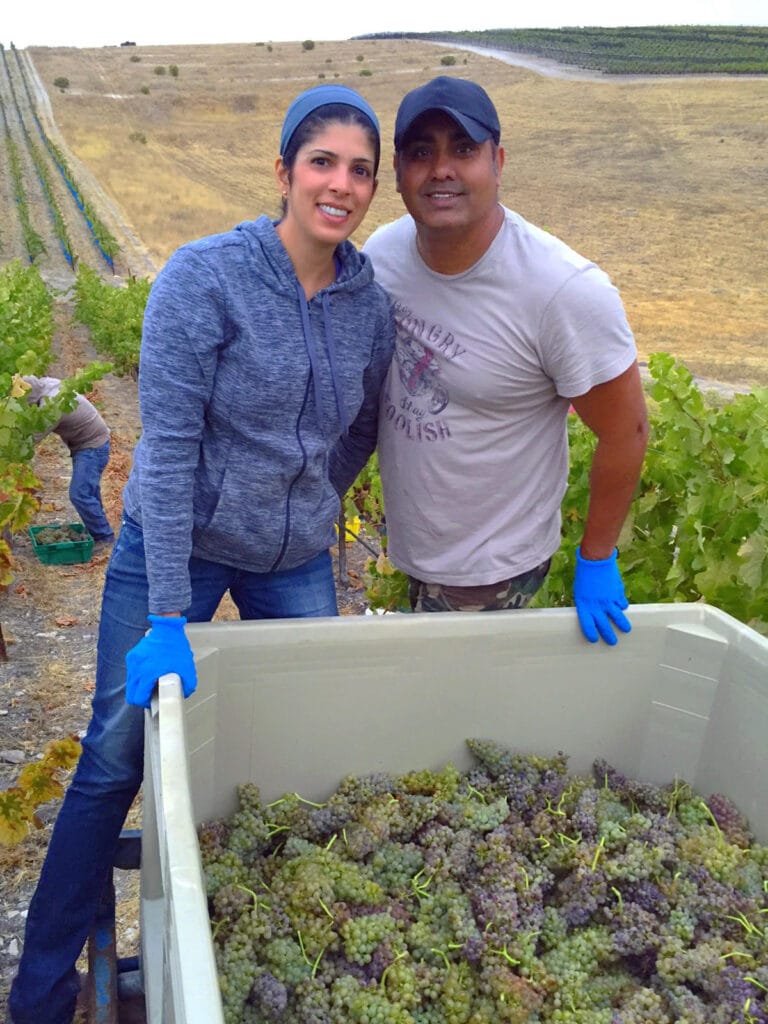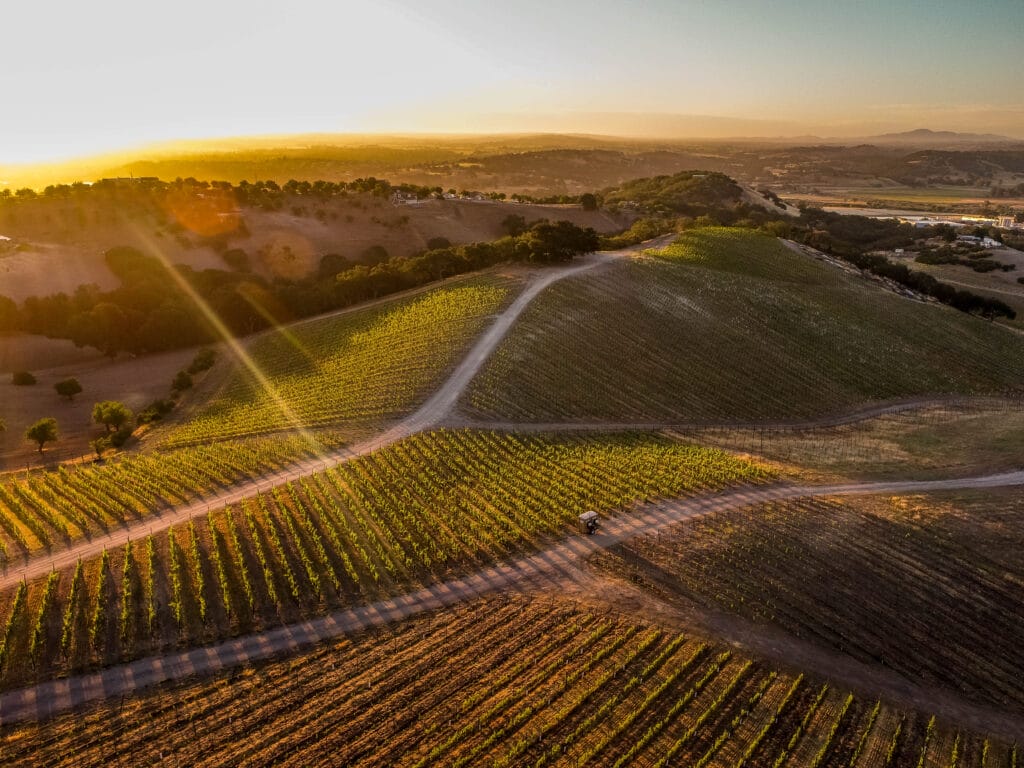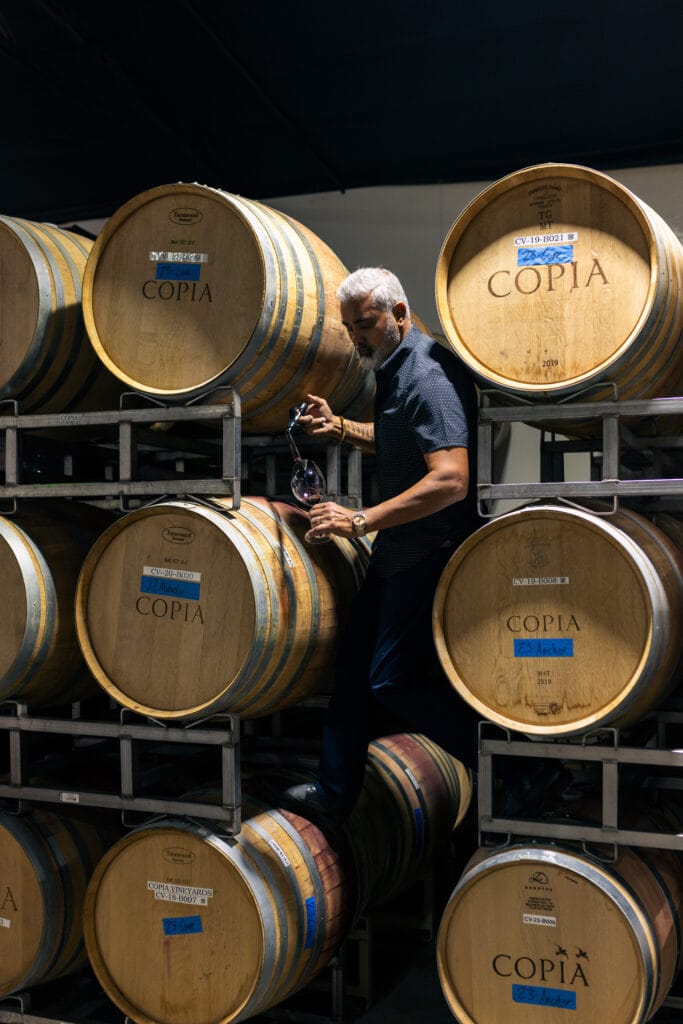Winery Story and New Reviews by Lisa Perrotti-Brown


COPIA
Written By Lisa Perrotti-Brown, MW
When Varinder and Anita Sahi first visited Paso Robles in 2015, they had no plans to buy land, start a vineyard, or reshape their lives around wine. They were accomplished professionals—Varinder a successful engineer and entrepreneur, Anita a marketing executive who had helped shape the branding of some of America’s most exclusive restaurants. But a weekend trip to California’s Central Coast changed everything.
FULL CIRCLE
“We didn’t know any of the wineries,” recalls Anita. “All we knew of Paso was a couple of larger names we’d seen in Midwest shops or on restaurant menus in Chicago. We had no idea of the discoveries we would make.”

Anita and Varinder Sahi
Eight winery visits later, they were captivated—not just by the wines, but by the people. “After spending two hours at each stop with the owners, winemakers, and hospitality teams, we were hooked,” she says. “The people of Paso Robles charmed their way into our hearts. It was our first visit, but it already felt like home.”
That sense of connection set the Sahis on a trajectory that would lead to the founding of Copia Vineyards, one of Paso’s rising boutique producers known for Rhône-style blends and a quietly obsessive approach to farming.
Varinder’s story begins far from California’s rolling hills. He was born in India, in Punjab, to a family with 13 generations of farmers behind them.
“My family were farmers,” he says. “When things changed, and our land became much smaller, we knew we had to become professionals.”
The shift came in the wake of India’s partition, when the family’s agricultural lands were divided and the next generation was encouraged to pursue more stable careers. Varinder followed that path—he became the first in his family to attend university in 1986, launching a career in engineering and business. Yet, the pull of the land never left him.
“I always wanted to get back to farming,” he says. “The first time I had wine at corporate dinners, I had no idea what I was having, but I loved it. I caught the bug and started studying wine.”
What began as curiosity turned into a calling. While still in the Midwest, Varinder convinced his father to sell five acres of family land to help him buy 20 acres in Lodi. “We planted grapes for Gallo,” he recalls. “By 2012, I got serious and went to UC Davis to study winemaking.”
By 2015, Varinder met Anita, who shared his growing passion for wine. Their fateful visit to Paso Robles followed soon after, and by the summer of 2016, they had packed their bags and driven west to work harvest.

The Sahis as Interns at Booker in 2016
“We became the oldest interns at Booker in 2016,” Varinder laughs. “Eric Jensen said, ‘If you’re crazy enough to learn all this, come in July and see the whole process.’ For me, this was coming back to my roots.”
The couple worked side by side in the cellar, gaining hands-on experience while forging friendships with the close-knit Paso community.
In 2017, the Sahis purchased their first estate—a steep, 50-acre property in the Willow Creek District. The site’s undulating terrain and calcareous soils were ideal for Rhône varieties.
“We bought this place in two parcels,” Varinder explains. “It’s 50 acres total. We applied for the winery permit in 2018 and got it in 2024. We were making wine at Denner Vineyard until 2022, when it was bought by Gallo.”
Their Willow Creek vineyard now has nearly 40,000 vines across 24 blocks, planted to Syrah, Grenache, Mourvèdre, and other Rhône varieties.

Copia Willow Creek Estate
The sale of Denner Vineyards, where Copia had been producing wine, prompted another turning point. “There was no intention to buy a second estate vineyard,” says Varinder, “but the extreme delay in our winery permitting, plus the sale of Denner, forced our hand.”
In the middle of the challenging 2022 harvest, the Sahis purchased a 26-acre property in the Adelaida District, which came with a modest winery building and tasting room.

Copia Tasting Room
“We desperately needed to find a new home to make our wine,” says Varinder. “Since then, we’ve remodeled the tasting room, expanded the winery, modernized the existing structure, and added a new fermentation room and lab.”
The couple also replanted 20 acres of the existing vines, transitioning them from conventional to sustainable farming practices. “2026 will be the first harvest from this vineyard,” Varinder notes proudly.
The new Adelaida site has become both Copia’s production home and a gathering space for visitors. The reimagined tasting room mirrors the Sahis’ aesthetic: elegant, contemporary, and rooted in authenticity. “We wanted the space to feel welcoming but refined,” Anita explains. “It’s a reflection of who we are and how we approach our wines—modern but deeply connected to tradition.”
For Varinder, winemaking begins long before the grapes reach the cellar. “My approach to winemaking is from a farming perspective, first,” he says. “It’s been said many times that you need to start with great grapes to make great wine. The degree of separation between good and great wine is very small, and that difference happens in the vineyard.”
Copia’s philosophy emphasizes meticulous attention to detail—from shoot thinning and fruit dropping to deficit irrigation—to achieve balance and phenolic ripeness.

“I’m not just looking for technological ripeness, meaning sugar levels,” Varinder explains. “I’m looking for phenolic ripeness—tannins, color, and flavor compounds. Having both perspectives allows me to make wines that are texturally and aromatically compelling and balanced.”
That precision extends to the cellar, where Varinder strives for what he calls “structural balance.”
“I’m looking to create a structurally balanced wine that respects the varietal and where it comes from,” he says. “What this means for me is that I am creating an opulent texture—a wine that can be enjoyable, albeit bold, in its youth, but has the structure and acid to age well. Copia’s wines are true to our westside Paso Robles terroir.”
That westside expression—characterized by limestone-rich soils, diurnal temperature shifts, and small-berry concentration—is central to Copia’s identity. Each wine, whether from estate fruit or select partner vineyards, is meant to reflect both place and precision.
If there’s one wine that embodies Copia’s philosophy, it’s The Source Syrah.
“Our favorite wine that we make is The Source Syrah,” says Anita. “It’s truly the varietal that launched our mission. It’s aptly named The Source because Syrah is the source of our inspiration for being in Paso Robles.”
Varinder adds, “We think Syrah from the westside of Paso Robles is uniquely expressive—sometimes giving you loads of black fruit, other times more peppery, gamey, and sanguine expressions. It’s always rich in texture and structure. To put it simply, it’s totally our jam.”

At the heart of Copia’s evolution is a dual devotion—to the land and to the people who share their table.
“We are farmers at heart,” says Varinder. “We focus on regenerative organic farming, as my forefathers did before commercially available fertilizers, pesticides, and herbicides were even invented. Where we farm is where we live, and we don’t want to put anything in the ground that we wouldn’t want in our bodies. And it’s the right thing to do for future generations.”
Anita adds that their philosophy extends beyond viticulture to the guest experience. “Equal to our love of the land is our passion for hospitality,” she says. “Culturally, we were raised to treat the guest as divine. To host someone, to care for them, and to anticipate their desires feeds our souls as much as winemaking does.”
Copia’s first vintage came in 2018, crafted at Denner with fruit sourced from leading Paso Robles growers. By 2021, the Sahis were using their own estate fruit for the first time.
With the completion of their winery permit and the expansion into Adelaida, Copia Vineyards is poised for a new chapter—one that merges both sites into a unified estate program focused on sustainability and terroir expression.
“We’ve finally reached a point where everything we envisioned is coming together,” says Anita. “Our two vineyards—Willow Creek and Adelaida—complement each other beautifully. They give us a diversity of microclimates and soil profiles that we can express through our wines.”
For Varinder, the connection to his family’s agrarian past remains at the center of it all. “When I’m walking the vineyard rows at sunrise, I think about my uncles working the fields in India,” he reflects. “It feels like I’ve come full circle.”

MOST RECENT REVIEWS BY LISA PERROTTI-BROWN’S THE WINE PALATE
2023 Copia The Source – 97 points
2023 Copia The Cure – 96 points
2023 Copia The Story – 95 points
Article from © 2025 The Wine Palate, Napa CA | Become A Wine Palate Member

